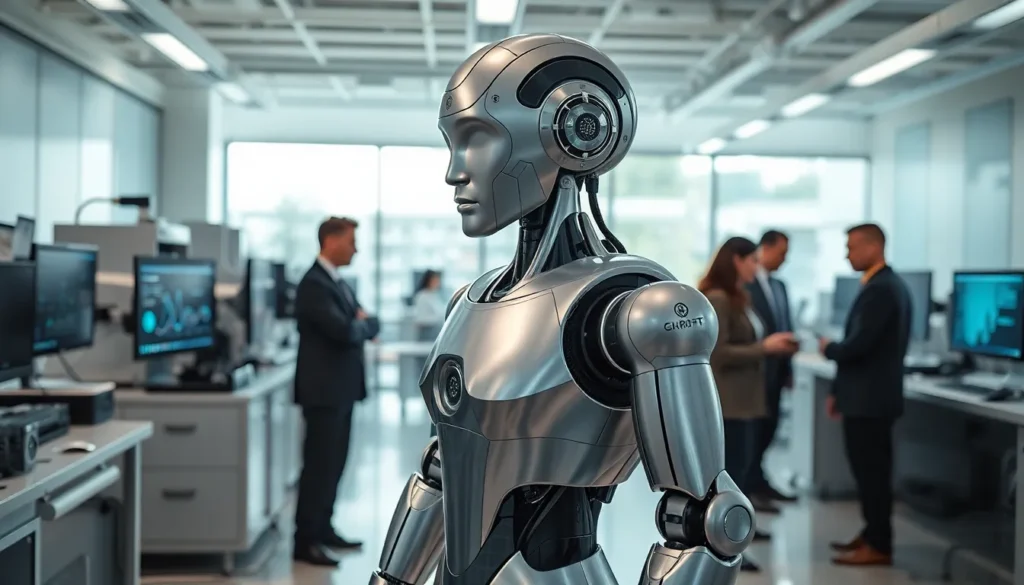Table of Contents
ToggleIn a world where robots might soon outsmart humans, one innovation stands tall: gray matter robotics. Imagine a realm where machines mimic not just human tasks but human thought processes as well. Sounds like a sci-fi movie? Well, buckle up. Gray matter robotics is not just a trend: it’s reshaping our future. From the factory floor to daily life, these intelligent systems are transforming industries, leaving outdated automation in the dust and sparking excitement. So, if you’re curious about how these advancements can elevate efficiency and creativity, you’re reading the right article.
Understanding Gray Matter Robotics

Gray matter robotics refers to advanced robotic systems that emulate cognitive functions, mirroring human-like reasoning and decision-making processes. Unlike traditional robotics, which often rely on pre-programmed tasks, these intelligent machines integrate machine learning and artificial intelligence to adapt and evolve based on environmental cues. This remarkable capability allows them to analyze vast amounts of data, make informed choices, and even learn from past experiences.
The term itself draws inspiration from the human brain’s gray matter, which plays a crucial role in processing information and executing higher-order cognitive functions. By attempting to replicate these capabilities, gray matter robotics certainly represents a significant leap into the future of automation.
The Components of Gray Matter Robotics
Developing proficient gray matter robotic systems requires several core components. First, we have sensors that collect data from the environment. These sensors are crucial, acting like the eyes and ears of the robot, enabling it to interact with its surroundings. Next, there’s the processing unit, which serves as the brain of the operation. This is where all the complex computations happen, employing algorithms to analyze and interpret the data gathered by the sensors.
Another essential element is the software that drives the decision-making process. Advanced AI and machine learning algorithms allow these robots to learn from interactions and experiences, refining their performances over time. Finally, movement mechanisms, including motors and actuators, translate digital decisions into physical actions, bridging the gap between intention and execution. Each of these elements plays a key role in achieving the remarkable potential of gray matter robotics.
Applications in Various Industries
Gray matter robotics finds applications across various industries, leading to remarkable efficiency and quality enhancements. In manufacturing, these robots come into play on the assembly line, performing tasks that require precision and adaptability. For instance, they can learn to adjust their assembly techniques based on the specific needs of different products, allowing for greater flexibility and reduction of waste.
In the healthcare sector, the robots assist surgeons in complex procedures, providing them with real-time data to improve accuracy. They also enhance patient care through automation, allowing for personalized therapy delivery.
Besides, in agriculture, these technologies optimize harvesting processes, enabling farmers to react swiftly to environmental changes, like adjusting watering schedules based on rainfall data. Whether it’s logistics, construction, or even service industries, gray matter robotics is making waves, revolutionizing not just the tasks they perform but the very fabric of how industries operate.
Benefits of Gray Matter Robotics
The benefits associated with gray matter robotics are manifold. First, they dramatically improve efficiency. By adapting to different tasks and learning from interactions, these robots minimize errors and reduce the time required to complete processes.
Also, there’s a notable improvement in precision. In sectors such as manufacturing and healthcare, where the slightest miscalculation can have dire consequences, the accuracy of gray matter robotics can make all the difference. This leads to better outcomes and enhances overall productivity.
Also, these systems can operate around the clock. By taking on repetitive or dangerous tasks, they free human workers to focus on more strategic and creative endeavors. This collaboration not only boosts productivity but also leads to a more striking work-life balance for staff. Eventually, gray matter robotics represents an essential shift towards smarter, safer, and more efficient industry practices.
Challenges and Limitations
Even though their potential, gray matter robotics also encounters several challenges and limitations. One significant hurdle is the ethical implications of using such advanced technology. As these robots assume various responsibilities, there’s a growing concern about job displacement and the consequences of losing human jobs to machines. Balancing technological advancement with workforce implications remains a critical conversation in many industries.
Another considerable challenge involves the technology itself. Developing reliable, resilient, and secure robotic systems that can operate in varied and sometimes unpredictable environments is complex. Also, the risk of hacking or malicious use underscores the importance of securing these machines against cybersecurity threats.
Finally, while the concept of gray matter robotics revolves around learning and adaptation, there are still considerable limitations in understanding context and nuance compared to humans. This discrepancy indicates that while these systems can enhance automation, they may not entirely replace human judgment or intuition.
The Future of Gray Matter Robotics: Trends and Innovations
Looking ahead, the future of gray matter robotics is laden with exciting trends and innovations. One prominent trend is the increasing integration of artificial intelligence and robotics, enabling faster learning and more sophisticated decision-making. As AI algorithms evolve, so too will the capacities of these machines to handle complex tasks across various environments.
Besides, collaborative robotics, where humans and robots work side by side, are gaining momentum. This cooperative approach allows robots to learn directly from human interactions, fostering an environment of shared growth and development.
Also, advancements in sensory technology contribute to more intuitive responses. With better sensors, gray matter robotics can capture more nuanced data about their surroundings, allowing for contextual decision-making that closely resembles human thought.
Finally, as ethical frameworks and regulations evolve, they will need to keep pace with technological advancements, ensuring that as we embrace these capabilities, we also consider the broader implications on society.




